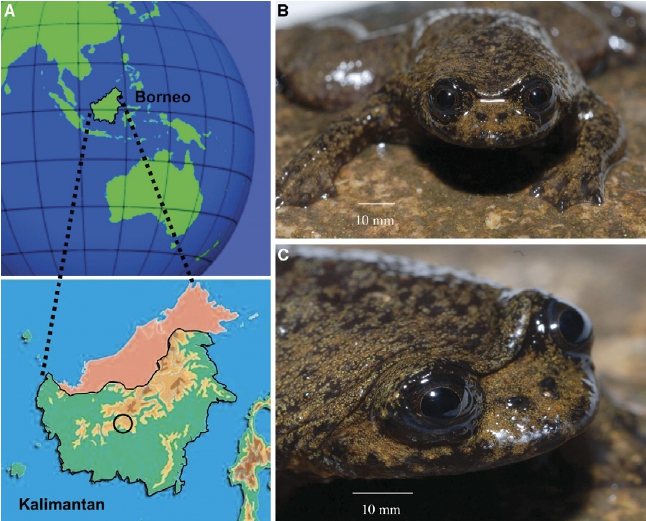| Citation |
|
Description |
Geographic Range [top]
Range Description: This species is known from central and western Kalimantan in Indonesian Borneo. It was formerly only known from the type locality: Nanga Sayan, 33 km south of Nanga Pinoh; and upstream of Nanga Sayan, Kelawit River, both in the Melawi River Basin (Iskandar 1978, 1995, Bickford et al. 2008). It is now also known from Ela Hulu Stream, and additional sites in Melopang Stream and Sokan River (D. Iskandar unpubl. data); Tengkalap River in the Belantikan River Basin, Central Kalimantan (Santoso et al. 2006), as well as, rivers flowing to east Kalimantan: Seruyan River, Lamandau and Belantikan Hulu and the Mendawai River Basin [Bahae Stream] (Rachmayuningtyas et al. 2011, Indonesia Red List Assessment Workshop May 2017). The species is probably extirpated at the type locality due to illegal gold mining (Rachmayuningtyas et al. 2011, D. Iskandar pers. comm. May 2017). Its estimated extent of occurrence (EOO) is 4,395 km2 and all individuals are considered to occur in three to five threat defined locations. Its elevational range is expected to be below 750 m asl.
Countries occurrence:
Native:
Indonesia (Kalimantan)
Additional data:
? Number of Locations: 3-5
? Upper elevation limit (metres): 750
Range Map: Click here to open the map viewer and explore range.
Population [top]
Population: This species was formerly only known from two specimens collected 20 years apart (Iskandar 1978, 1995). In August 2007, two new subpopulations were discovered upstream of the type locality (Bickford et al. 2008). Before this rediscovery, surveys of suitable habitat had not recovered any further specimens, suggesting that this species has a very limited distribution and/or is very rare (Rachmayuningtyas et al. 2011). Several additional specimens have been recorded in subsequent surveys at various localities in central Kalimantan (Santoso et al. 2006, Rachmayuningtyas et al. 2011). Due to ongoing decline in the extent and quality of habitat, the population is suspected to be decreasing.
Current Population Trend: Decreasing
Additional data:
? Population severely fragmented: No
Habitat and Ecology [top]
Habitat and Ecology: This species inhabits relatively shallow, cold, fast-flowing, clear, rocky streams in primary tropical lowland rainforest (Rachmayuningtyas et al. 2011). It is a fully aquatic, lungless species (Bickford et al. 2008), and requires pristine, clear water with a high oxygen content (Prakoso et al. unpublished data). Its breeding ecology is not known. It has not been found in open areas outside forest.
Systems: Freshwater
Continuing decline in area, extent and/or quality of habitat: Yes
Movement patterns: Not a Migrant
Use and Trade [top]
Use and Trade:
The species is accidentally caught in fish traps and consumed locally. The bones of the species are also used in traditional practices as they are believed to help in the development of babies and to provide them with protection: the bones are placed beneath babies’ beds (Indonesia Red List Assessment Workshop May 2017).
Threats [top]
Major Threat(s):
Illegal gold mining has destroyed all suitable habitat in the vicinity of the type locality (Bickford et al. 2008, Rachmayuningtyas et al. 2011), and the rivers have become severely degraded as a result of siltation and also pollution from mercury contamination (following its use for gold extraction). The originally cool and clear rivers are now warm and turbid, and the water quality at the type locality is no longer suitable for the species (Bickford et al. 2008). The two subpopulations discovered in 2007 are found upstream of the type locality (Bickford et al. 2008), however there is evidence that illegal mining is continuing up the watercourses around the area (Rachmayuningtyas et al. 2011).
In addition, both legal and illegal logging are ongoing activities in much of the surrounding terrestrial habitat (Bickford et al. 2008) caused by forest concessions and local use of the forest, and the species is probably also affected by siltation of its aquatic habitat and increased water temperatures following deforestation of the surrounding land (Rachmayuningtyas et al. 2011). The species is collected and used by local people for subsistence and represent a symbol of protection (Indonesia Red List Assessment Workshop May 2017). Climate change is also proposed as a threat to this species, while habitat specificity due to lunglessness and low genetic variability could make the species further vulnerable to environmental changes (Rachmayuningtyas et al. 2011).
Conservation Actions [top]
Conservation Actions: Conservation Actions
Although it has so far only been recorded in the buffer zone of Bukit Baka Bukit Raya National Park, it probably occurs within the park. The species habitat specificity and low adaptability merits its consideration for inclusion in the list of protected animals of Indonesia (Rachmayuningtyas et al. 2011).
Conservation Needed
Protection of stream head waters and surrounding forest habitats where this species occurs is critical for the species survival. Legal protection of this species by the Indonesian government is recommended.
Research Needed
More information is needed on this species distribution, population status, ecology, and threats.
Citation: IUCN SSC Amphibian Specialist Group. 2018. Barbourula kalimantanensis. The IUCN Red List of Threatened Species 2018: e.T54444A3015179. http://dx.doi.org/10.2305/IUCN.UK.2018-2.RLTS.T54444A3015179.en. Downloaded on 09 January 2019.
Disclaimer: To make use of this information, please check the .
Feedback: If you see any errors or have any questions or suggestions on what is shown on this page, please provide us with feedback so that we can correct or extend the information provided
|


